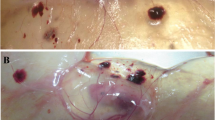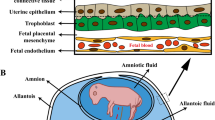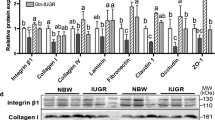Abstract
Embryonic loss is a major problem in mammals, but there are few effective ways to prevent it. Using a porcine model, we determined effects of dietary l-arginine supplementation between days 14 and 25 of gestation on embryonic growth and survival. Gilts were checked daily for estrus with boars in the morning and bred at onset of the second estrus and 12 h later (the time of breeding = day 0 of gestation). Between days 14 and 25 of gestation, 15 gilts/treatment were housed individually and fed twice daily 1 kg of a corn- and soybean meal-based diet supplemented with 0.0, 0.4, or 0.8 % l-arginine. All diets were made isonitrogenous by addition of l-alanine. On day 25 of gestation, gilts were hysterectomized to obtain conceptuses. Compared with controls, dietary supplementation with 0.4 or 0.8 % l-arginine increased (P ≤ 0.05) arginine concentrations in maternal plasma, total volume of amniotic fluid; total amounts of arginine in allantoic and amniotic fluids; total amounts of fructose and most amino acids in amniotic fluid; placental growth; and the number of viable fetuses per litter by 2. The numbers of total fetuses, fetal weight, corpora lutea, volume of allantoic fluid, maternal circulating levels of progesterone and estrogen, or total amounts of hormones in allantoic fluid did not differ among the three treatment groups. Reproductive performance of gilts did not differ between the 0.4 and 0.8 % l-arginine groups. Thus, dietary supplementation with 0.4 or 0.8 % l-arginine between days 14 and 25 of gestation enhances embryonic/fetal survival in swine.
Similar content being viewed by others
Abbreviations
- ALF:
-
Allantoic fluid
- AMF:
-
Amniotic fluid
- CL:
-
Corpora lutea
- NO:
-
Nitric oxide
- NRC:
-
National Research Council
References
Bazer FW (1989) Allantoic fluid: regulation of volume and composition. In: Brace RA, Ross MG, Robillard JE (eds) Reproduction and perinatal medicine. Fetal and neonatal body fluids. Ithaca: Perinatology, vol. 11, p 135–155
Bazer FW, Thatcher WW (1977) Theory of maternal recognition of pregnancy in swine based on estrogen controlled endocrine versus exocrine secretion of prostaglandin F2alpha by the uterine endometrium. Prostaglandins 14:397–401
Bazer FW, Wu G, Spencer TE et al (2010) Novel pathways for implantation and establishment and maintenance of pregnancy in mammals. Mol Hum Reprod 16:135–152
Bazer FW, Song GH, Kim JY et al (2012) Mechanistic mammalian target of rapamycin (MTOR) cell signaling: effects of select nutrients and secreted phosphoprotein 1 on development of mammalian conceptuses. Mol Cell Endocrinol 354:22–33
Bérard J, Bee G (2010) Effects of dietary l-arginine supplementation to gilts during early gestation on foetal survival, growth and myofiber formation. Animal 4:1680–1687
Costa RP, Costa AS, Korzekwa AJ et al (2008) Actions of a nitric oxide donor on prostaglandin production and angiogenic activity in the equine endometrium. Reprod Fertil Dev 20:674–683
Dai ZL, Li XL, Xi PB et al (2012a) Regulatory role for l-arginine in the utilization of amino acids by pig small-intestinal bacteria. Amino Acids 43:233–244
Dai ZL, Li XL, Xi PB et al (2012b) Metabolism of select amino acids in bacteria from the pig small intestine. Amino Acids 42:1597–1608
Gao KG, Jiang ZY, Lin YC et al (2012) Wu G. Dietary l-arginine supplementation enhances placental growth and reproductive performance in sows. Amino Acids 42:2207–2214
Geng MM, Li TJ, Kong XF et al (2011) Reduced expression of intestinal N-acetylglutamate synthase in suckling piglets: a novel molecular mechanism for arginine as a nutritionally essential amino acid for neonates. Amino Acids 40:1513–1522
Go GW, Wu G, Silvey DT et al (2012) Lipid metabolism in pigs fed supplemental conjugated linoleic acid and/or dietary arginine. Amino Acids 43:1713–1726
Kim JY, Burghardt RC, Wu G et al (2011) Select nutrients in the ovine uterine lumen. VIII. Arginine stimulates proliferation of ovine trophectoderm cells through MTOR-RPS6 K-RPS6 signaling cascade and synthesis of nitric oxide and polyamines. Biol Reprod 84:70–78
Kim JY, Song GW, Wu G et al (2012) Functional roles of fructose. Proc Natl Acad Sci USA 109:E1619–E1628
Kong XF, Tan BE, Yin YL et al (2012) l-Arginine stimulates the mTOR signaling pathway and protein synthesis in porcine trophectoderm cells. J Nutr Biochem 23:1178–1183
Li XL (2011) Regulation of porcine conceptus survival and growth by l-arginine (Ph D Dissertation). Texas A&M University, College Station
Li X, Bazer FW, Johnson GA et al (2010) (2010), Dietary supplementation with 0.8% l-arginine between Days 0 and 25 of gestation reduces litter size in gilts. J Nutr 140:1111–1116
Li XL, Rezaei R, Li P et al (2011) Composition of amino acids in feed ingredients for animal diets. Amino Acids 40:1159–1168
Liu XD, Wu X, Yin YL et al (2012) Effects of dietary l-arginine or N-carbamylglutamate supplementation during late gestation of sows on the miR-15b/16, miR-221/222, VEGFA and eNOS expression in umbilical vein. Amino Acids 42:2111–2119
Mateo RD, Wu G, Bazer FW et al (2007) Dietary l-arginine supplementation enhances the reproductive performance of gilts. J Nutr 137:652–656
McKnight JR, Satterfield MC, Jobgen WS et al (2010) Beneficial effects of l-arginine on reducing obesity: potential mechanisms and important implications for human health. Amino Acids 39:349–357
National Research Council (NRC) (1998) Nutrient requirements of swine, 10th edn. National Academic Press, Washington, DC
Pope WF (1994) Embryonic mortality in swine. In: Zavy M, Geisert R (eds) Embryonic mortality in domestic species. CRC Press, Boca Raton, pp 53–77
Ramaekers P, Kemp B, van der Lende T (2006) Progenos in sows increases number of piglets born. J Anim Sci 84(Suppl1):394 (Abstract)
Ren W, Yin YL, Liu G et al (2012) Effect of dietary arginine supplementation on reproductive performance of mice with porcine circovirus type 2 infection. Amino Acids 42:2089–2094
Ren WK, Luo W, Wu MM et al (2013) Dietary l-glutamine supplementation improves pregnancy outcome in mice infected with type-2 porcine circovirus. Amino Acids 45:479–488
Reynolds LP, Borowicz PP, Vonnahme KA et al (2005) Placental angiogenesis in sheep models of compromised pregnancy. J Physiol 565:43–58
Rhoads JM, Wu G (2009) Glutamine, arginine, and leucine signaling in the intestine. Amino Acids 37:111–122
Roe JH (1934) A colorimetric method for the determination of fructose in blood and urine. J Biol Chem 107:15–22
Salvemini D, Misko TP, Masferrer JL et al (1993) Nitric oxide activates cyclooxygenase enzymes. Proc Natl Acad Sci USA 90:7240–7244
Satterfield MC, Dunlap KA, Keisler DH et al (2012) Arginine nutrition and fetal brown adipose tissue development in diet-induced obese sheep. Amino Acids 43:1593–1603
Satterfield MC, Dunlap KA, Keisler DH et al (2013) Arginine nutrition and fetal brown adipose tissue development in nutrient-restricted sheep. Amino Acids 45:489–499
Schoknecht PA, Pond WG, Mersmann HJ et al (1993) Protein restriction during pregnancy affects postnatal growth in swine progeny. J Nutr 123:1818–1825
Schoknecht PA, Newton GR, Weise DE et al (1994) Protein restriction in early pregnancy alters fetal and placental growth and allantoic fluid proteins in swine. Theriogenology 42:217–226
Smith MF, McIntush EW, Smith GW (1994) Mechanisms associated with corpus luteum development. J Anim Sci 72:1857–1872
Suryawan A, Davis TA (2011) Regulation of protein synthesis by amino acids in muscle of neonates. Front Biosci 16:1445–1460
Vonnahme KA, Ford SP (2004) Placental vascular endothelial growth factor receptor system mRNA expression in pigs selected for placental efficiency. J Physiol 554:194–201
Wu G (2013a) Functional amino acids in nutrition and health. Amino Acids 45:407–411
Wu G (2013b) Amino acids: biochemistry and nutrition. CRC Press, Boca Raton, Florida p 503
Wu G, Morris SM Jr (1998) Arginine metabolism: nitric oxide and beyond. Biochem J 336:1–17
Wu G, Bazer FW, Tuo W (1995) Developmental changes of free amino acid concentrations in fetal fluids of pigs. J Nutr 125:2859–2868
Wu G, Pond WG, Ott TL et al (1998a) Maternal dietary protein deficiency decreases amino acid concentrations in fetal plasma and allantoic fluid of pigs. J Nutr 128:894–902
Wu G, Pond WG, Flynn SP et al (1998b) Maternal dietary protein deficiency decreases nitric oxide synthase and ornithine decarboxylase activities in placenta and endometrium of pigs during early gestation. J Nutr 128:2395–2402
Wu G, Bazer FW, Wallace JM et al (2006) Board-invited review: intrauterine growth retardation: implications for the animal sciences. J Anim Sci 84:2316–2337
Wu G, Bazer FW, Davis TA et al (2009) Arginine metabolism and nutrition in growth, health and disease. Amino Acids 37:153–168
Wu G, Bazer FW, Burghardt RC et al (2010) Impacts of amino acid nutrition on pregnancy outcome in pigs: mechanisms and implications for swine production. J Anim Sci 88:E195–E204
Wu G, Bazer FW, Satterfield MC et al (2013a) Impacts of arginine nutrition on embryonic and fetal development in mammals. Amino Acids 45:241–256
Wu G, Wu ZL, Dai ZL et al (2013b) Dietary requirements of “nutritionally nonessential amino acids” by animals and humans. Amino Acids 44:1107–1113
Wu G, Bazer FW, Johnson GA et al (2013c) Maternal and fetal amino acid metabolism in gestating sows. Soc Reprod Fertil Suppl 68:185–198
Xi PB, Jiang ZY, Zheng CT et al (2011) Regulation of protein metabolism by glutamine: implications for nutrition and health. Front Biosci 16:578–597
Yao K, Yin YL, Chu W et al (2008) Dietary arginine supplementation increases mTOR signaling activity in skeletal muscle of neonatal pigs. J Nutr 138:867–872
Zeng X, Wang F, Fan X et al (2008) Dietary arginine supplementation during early pregnancy enhances embryonic survival in rats. J Nutr 138:1421–1425
Acknowledgments
This study was supported by National Research Initiative Competitive Grants from the Animal Reproduction Program (2008-35203-19120) and Animal Growth & Nutrient Utilization Program (2008-35206-18764) of the USDA National Institute of Food and Agriculture, Texas AgriLife Research (No. 8200), National Natural Science Foundation of China (31272217 and 31272450), Chinese Universities Scientific Funds (2012RC024), and the Thousand-People-Talent program at China Agricultural University.
Conflict of interest
The authors declare no conflicts of interest.
Author information
Authors and Affiliations
Corresponding author
Rights and permissions
About this article
Cite this article
Li, X., Bazer, F.W., Johnson, G.A. et al. Dietary supplementation with l-arginine between days 14 and 25 of gestation enhances embryonic development and survival in gilts. Amino Acids 46, 375–384 (2014). https://doi.org/10.1007/s00726-013-1626-6
Received:
Accepted:
Published:
Issue Date:
DOI: https://doi.org/10.1007/s00726-013-1626-6




